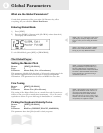
7 Editing Programs
33
QS Composite Synthesis™
The QS generates sound through the use of QS Composite Synthesis™.
The basis of this technology is the playback and processing of audio
samples. A sample is a digital recording of a sound. The sound could
be a sine wave, a grand piano, or even a full orchestra.
The QS processes these samples by applying filters, envelopes and
modulations, and then mixing them with other processed samples. In
this way, the QS can create a universe of sounds.
The Voice
The part of the QS that plays back a sample is called a Voice. The QS
has 64 Voices, so it can play 64 sounds at the same time.
Lowpass Filter
The output of the Voice feeds into a lowpass filter, which dampens
high frequencies and allows low frequencies to pass through. The
frequency at which the dampening begins is called the filter frequency.
The lower the filter frequency, the more muted the sound.
Amplifier
Each voice/filter combination is followed by an amplifier whose level
can be controlled by a variety of sources. This allows for creating sounds
with either percussive or slow attacks, or particular types of decays, or
tremolo, etc.
The Four Sound Layers of a Program
Each voice/filter/amplifier group is called a Sound. Up to four Sounds
can be used in a Program. You can overlap Sounds, split them across the
keyboard, or any combination of these.
The number of Sounds being used by a Program has a direct effect on
the QS’s polyphony. If the current Program uses only one Sound, you’ll
be able to play 64 simultaneous notes. A Program using two Sounds will
be limited to 32 simultaneous notes, and so on.
Amplitude
Frequency
Filter Frequency


















